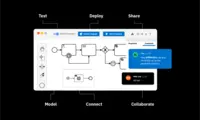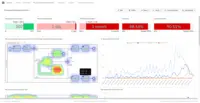Starting at $2 per month
View PricingOverview
What is Camunda?
Camunda is a process orchestration tool designed to help organizations design, automate, and improve any process. Built for business and IT collaboration using BPMN and DMN standards, Camunda aims to enable seamless integration across endpoints to transform mission-critical processes.
Recent Reviews
Pricing
Self-Managed Free
$0
On Premise
SaaS Free
$0
Cloud
per month
SaaS Starter
$99
Cloud
per month
Entry-level set up fee?
- No setup fee
For the latest information on pricing, visithttps://camunda.com/pricing
Offerings
- Free Trial
- Free/Freemium Version
- Premium Consulting/Integration Services
Starting price (does not include set up fee)
- $2 per month
Product Demos
Camunda Optimize: Continuously Improve Your Business Processes
YouTube
Camunda x Sky: Accelerate Digital Transformation
YouTube
Camunda Question Corner #22: A New SDK for Connectors in Camunda Platform 8
YouTube
Camunda Live Demo: Design, implementation, operation and optimization - Benjamin Hoffmann, Camunda
YouTube
Product Details
- About
- Competitors
- Tech Details
- Downloadables
- FAQs
What is Camunda?
Camunda enables organizations to orchestrate processes across people, systems, and devices to continuously overcome complexity and increase efficiency. A common visual language enables collaboration between business and IT teams to design, automate, and improve end-to-end processes with the required speed, scale, and resilience to remain competitive. The vendor states enterprises such as Atlassian, ING, and Vodafone orchestrate business-critical processes with Camunda to accelerate digital transformation.
Camunda Features
Process Engine Features
- Supported: Process designer
- Supported: Process simulation
- Supported: Business rules engine
- Supported: SOA support
- Supported: Process player
- Supported: Form builder
- Supported: Model execution
Business Process Automation Features
- Supported: Business Process Modeling
- Supported: Decision Modeling
Reporting & Analytics Features
- Supported: Dashboards
- Supported: Standard reports
- Supported: Custom reports
Customization Features
- Supported: API for custom integration
- Supported: Plug-ins
Camunda Screenshots
Camunda Video
Camunda - The Universal Process Orchestrator
Camunda Competitors
Camunda Technical Details
| Deployment Types | On-premise, Software as a Service (SaaS), Cloud, or Web-Based |
|---|---|
| Operating Systems | Windows, Linux, Mac |
| Mobile Application | No |
Camunda Downloadables
Frequently Asked Questions
Camunda is a process orchestration tool designed to help organizations design, automate, and improve any process. Built for business and IT collaboration using BPMN and DMN standards, Camunda aims to enable seamless integration across endpoints to transform mission-critical processes.
Camunda starts at $2.
The most common users of Camunda are from Enterprises (1,001+ employees).





